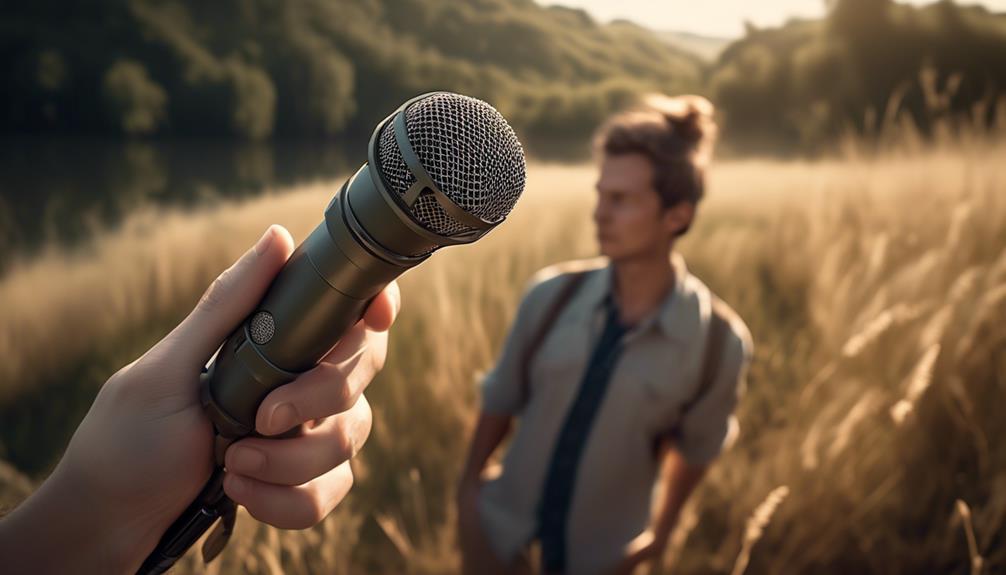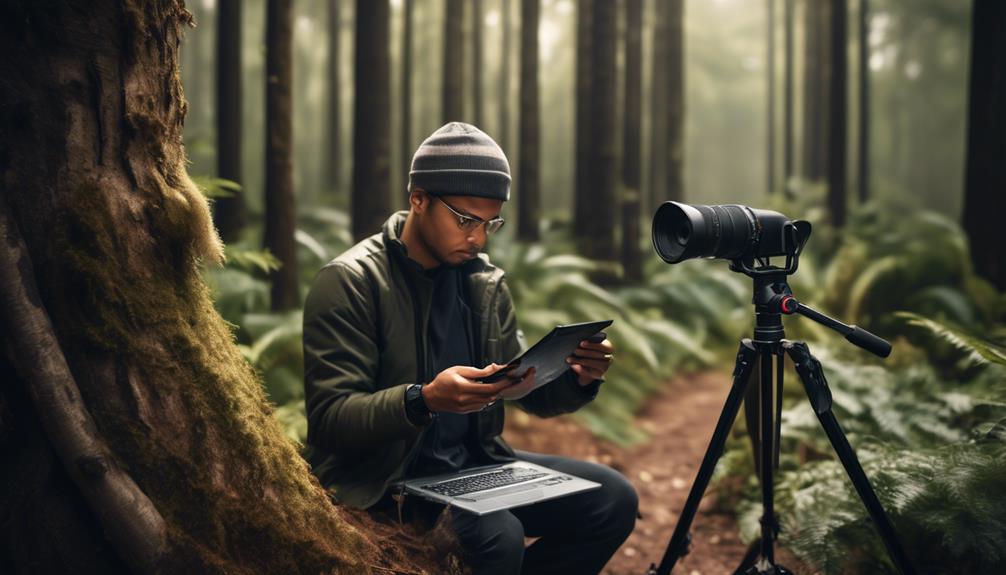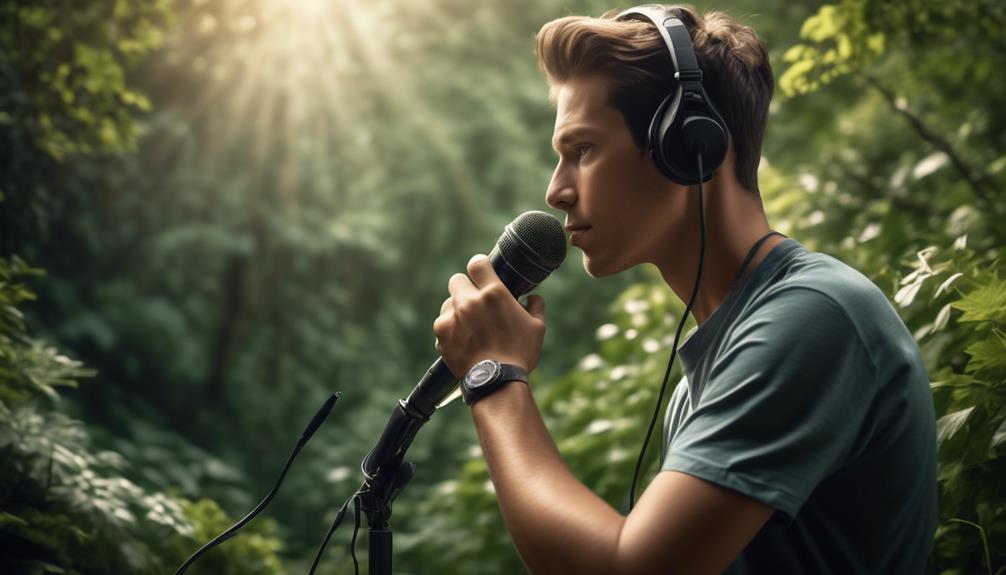So, you’ve made the decision to begin the exciting adventure of field recording. It’s more than just pressing the record button and crossing your fingers. There are subtleties and skills that can significantly impact capturing the true essence of a place.
From selecting the right equipment to honing your listening skills, field recording demands a level of attention and patience that is both challenging and rewarding.
But fear not, for we are here to guide you through the intricate art of capturing the world's sonic tapestry.
Key Takeaways
- High-quality portable audio recorders and professional-grade microphones are essential for field recording.
- Wind protection accessories should be used to minimize interference from wind noise.
- Experimenting with different recording techniques and microphone placements can lead to unique and compelling sounds.
- Monitoring the audio and adjusting sound levels during recording is important for achieving optimal results.
Essential Field Recording Equipment
When embarking on field recording, it's essential to equip ourselves with high-quality portable audio recorders, professional-grade microphones, closed-back headphones, wind protection accessories, and sturdy support equipment.
A reliable portable audio recorder, such as the Zoom H4n or Tascam DR-40x, is crucial for capturing high-quality field recordings on the go.
Investing in quality microphones, such as shotgun, stereo, or omnidirectional types, enables versatile and high-fidelity sound capture, essential for achieving professional results in various recording environments.
Closed-back headphones are indispensable for monitoring and adjusting sound levels, ensuring accurate recording and positioning.
Wind protection accessories like windshields and blimps are vital to minimize wind interference and handling noise during outdoor recordings, preserving the integrity of the captured sound.
Additionally, carrying sturdy support equipment such as stands, grips, cables, and memory cards is necessary to ensure stable and uninterrupted field recording sessions.
Techniques for Quality Field Recording

Equipped with high-quality portable audio recorders, professional-grade microphones, closed-back headphones, wind protection accessories, and sturdy support equipment, we now turn our focus to the essential techniques for achieving top-notch field recordings.
When capturing nature sounds, it's crucial to use wind protection accessories like windjammers and blimps to minimize interference from wind noise. Additionally, controlling environmental sounds and reducing handling noise are vital for capturing high-quality ambient sounds.
As field recordists, we must experiment with different recording techniques and microphone placements to achieve the desired results. It's also essential to use headphones to monitor and adjust sound levels during recording, enabling us to listen closely to every sound and capture hidden details and variations.
Interacting with sound sources by experimenting with gestures and interactions can also lead to the creation of unique sounds, making the process of sound design rewarding and enriching.
Mastering these techniques will elevate the quality of our field recordings, allowing us to capture the purest and most immersive nature sounds.
Tips for Successful Field Recording
To ensure successful field recording, it's essential to meticulously assess the environmental conditions and select appropriate equipment and techniques.
When evaluating environmental conditions, consider the presence of ambient noise, weather factors, and the desired natural sounds.
Selecting the right equipment is crucial. The Zoom H6 Handy Recorder or the Sound Devices MixPre series offer high-quality audio and versatile options for XLR inputs. For capturing natural sounds, condenser microphones with adjustable polar patterns and wide frequency response are recommended.
In the 'Beginner's Guide to Field Recording,' it's important to remember that technique plays a significant role in achieving optimal results. Utilize wind protection for microphones when recording outdoors and experiment with microphone placement to capture the best sound. Additionally, monitoring the audio using quality headphones is essential to ensure the recording is successful.
Mastering Field Recording Environments

Mastering field recording environments requires precise monitoring with headphones to ensure optimal sound quality and control over environmental factors using tools such as windjammers, blimps, and improvised methods. By employing these techniques, field recording enthusiasts can elevate the quality of their recordings and ensure a more controlled and professional outcome.
Embrace the power of nature: Immerse yourself in the sounds of the natural world and appreciate the diverse range of audio experiences it offers.
Experiment with interactions: Engage with your surroundings and explore different ways to interact with the environment to capture unique and varied sounds.
Embrace adaptable tools: Utilize versatile tools such as the Zoom H series digital recorder or other high-quality audio recorders to efficiently capture the essence of the field recording environment.
In the world of field recording, achieving mastery in recording nature and the surrounding environment hinges on the ability to precisely monitor and control sound quality. With the right tools and techniques, one can delve into the rich tapestry of sounds that the natural world has to offer.
The Art of Field Recording
Monitoring and controlling sound quality is essential in mastering field recording environments, and this expertise seamlessly translates into the art of field recording, where one must skillfully capture and manipulate diverse sounds and environments. When venturing into the art of field recording, it's crucial to understand the principles of sound waves and how they interact with the environment. To help illustrate this, we have provided a table below comparing different microphone options to aid in capturing sound waves effectively.
| Microphone Type | Description |
|---|---|
| Built-in Stereo | These microphones are ideal for recording in a 360-degree soundscape, capturing sounds directly in front and behind the mic. |
| Shotgun | Ideal for focusing on a specific sound source, these mics record one sound directly in front of the microphone. |
| Omnidirectional | These microphones pick up sounds from all directions, making them suitable for capturing a wide range of ambient sounds. |
| Binaural | This kind of mic records sounds just like the human ears hear them, making it perfect for creating a lifelike, immersive experience. |
Understanding the nature of sound waves and selecting the appropriate equipment is essential in achieving the desired results in the art of field recording. Experimenting with different microphones and understanding the kind of mic that best suits the sound you're going for is essential. When first starting, it's advisable to buy a microphone like the Zoom H1n, as it provides a good balance between cost and functionality. Mastery of field recording requires an understanding of the equipment and the environment to capture the most authentic and compelling sounds.
Frequently Asked Questions
How Do You Record in the Field?
When we record in the field, we focus on capturing the purest sounds. We bring essential equipment to ensure high-quality recordings in any sound environment.
We use various techniques to overcome challenges and capture wildlife, urban, natural ambience, and historical sounds. We aim to preserve cultural significance and use audio storytelling to convey the essence of the environment.
What Do You Need for Field Recording?
For field recording, equipment essentials include a portable recorder, headphones, wind protection, additional microphones, stands, and memory cards.
Location scouting is crucial to find optimal sound isolation and minimize ambient noise. Wind protection is essential for outdoor recording, and wildlife encounters can add unique sounds.
Audio monitoring is vital, especially in remote settings. We must consider the environmental impact and use interview techniques for precise recordings.
What Is the Best Sample Rate for Field Recording?
For field recording, the best sample rate is 48 kHz, ensuring high audio quality for a wide range of applications.
However, environmental factors, equipment options, and recording strategy can influence this choice. Consider 96 kHz for detailed sounds like wildlife, while 44.1 kHz saves storage.
Post processing and soundscapes analysis may also impact the ideal sample rate.
Location scouting and understanding natural acoustics are crucial for capturing the best audio quality.
Why Do People Do Field Recordings?
We do field recordings to capture the raw and evocative essence of environments. These recordings inspire creativity, providing a diverse palette of environmental sounds for music, film, and art.
Documenting nature, urban exploration, and cultural preservation are integral to our practice. It's about preserving history and wildlife, and expressing artistic vision through immersive soundscapes.
Field recording is an exploration of the world's rich auditory tapestry, fueling our passion for authentic and evocative storytelling.
Conclusion
In conclusion, field recording is the ultimate way to capture the world around us in all its intricate and immersive glory.
By using the right equipment, techniques, and mastering the environment, we can uncover a symphony of unique and captivating sounds.
So, grab your gear, venture out into the great unknown, and prepare to be blown away by the extraordinary auditory experiences waiting to be discovered.
Happy recording!










